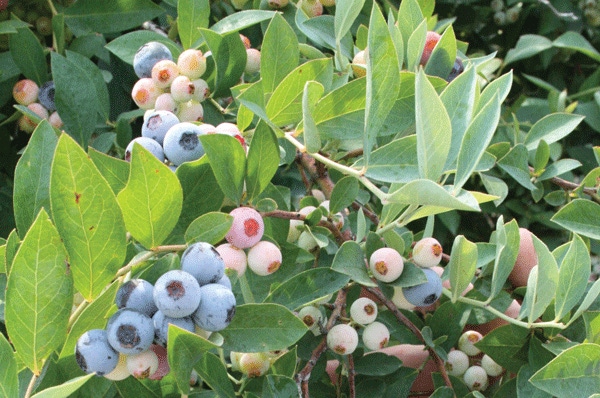February 23, 2011

The following article is prepared based on a synopsis of information provided by Phil Brannen (UGA), Gerard Krewer (UGA Professor Emeritus), Bill Cline (NC State), Dave Lockwood (University of Tennessee), and Danny Stanaland (UGA); relative to a suggested response to the recent extensive cold damage observed on blueberries in Georgia. The extent of the damage may vary throughout the state, but it is somewhat universal for blueberries grown anywhere along the same latitude as Georgia and is observed in southern Alabama. Based on initial reports and opinions based on past observations by field specialists, it is predicted that this cold damage will have a significant impact on yield this year, but that remains to be seen.
The November-January cold snaps have caused significant tissue damage on blueberries, especially young plants. Generally, plants may not have "hardened off" well in the fall, as the temperatures were exceptionally high up to the point they were exceptionally low.
Young rabbiteyes grew extensively in the fall, because of the 80 degree plus days in late November. This was immediately followed by a drop to 22 F eight days later. Tips of the most vigorous shoots are often dead and the core of the shoot is dead 3 inches to 4 inches below this point. Spring shoots are reported to look better, but in many cases, the leaves are "fried." The problem varies by cultivar, as one might expect.
The damage is immediate, but there is a secondary danger of significant infection and disease caused by Botryosphaeria fungi that causes blueberry stem blight disease. Stem blight takes a while to move into cold-injured blueberry shoots, but it will definitely invade them eventually.
Pruning is required in the late January to early February timeframe to address this situation. Even though there is not sufficient information of a cost/benefit ratio, in a year such as this, it is highly likely that pruning out the infected plant parts will pay off in the current season and for seasons to come.
Krewer says that “We have seen dead shoot tips before in association with copper deficiency. Some growers who left them in 2008 and 2010 had a serious stem blight problem in the spring and had to do massive pruning to save the plants.”
Watch plants carefully
Producers should watch plants carefully for Botryosphaeria in the spring and summer, and if additional pruning is conducted under warm conditions, a fungicide application is generally recommended after each day of pruning, and the fungicides are often also of benefit for fruit rots and leaf spots (killing two birds with the same stone). Also, do not push plants with early nitrogen this spring, as this might further exacerbate the situation with Botryosphaeria.
Pruning out damaged plant tissue will prevent Botryosphaeria stem blight from exploding in the spring. This is especially true for young plants (1 to 3 years old), and fertigated plants, so if one has to prioritize, one might prune these first. Generally, we have more problems with Botryosphaeria on southern highbush, but we have had tremendous problems with Botryosphaeria on young fertigated rabbiteyes in the last 2 to 3 years as well.
Once the extent of the damage is observed, there will be an advantage to pruning out dead tissue, and there is research information from North Carolina to back this up.
Cline reported a similar situation in 1992. A "Murphy" planting in Bladen County was examined bi-weekly or monthly for the first 3 years to determine conditions associated with high plant mortality in young bushes. Plants grew profusely and did not become completely dormant in 1992, and 139 of 500 bushes were cold injured at first frost in November.
Cold-injured stems developed a characteristic dead, hook-shaped tip that persisted throughout the following growing season. The presence of Botryosphaeria stem blight was confirmed on these tips, and in 1993, the incidence of Botryosphaeria stem blight in stems injured by cold the previous November was 19, 39, and 88 percent for March, May, and June, respectively.
Widespread infection by Botryosphaeria stem blight following cold injury was reported to account for past observations of field epidemics 1 to 2 years after planting. The take home message from this is that injured stems are colonized early, disease incidence increases with time and temperature, and the later you wait past February to prune, the more disease you are likely to see.
In cases such as this, Lockwood has generally advised growers to delay pruning until late winter/early spring so that they can feel relatively sure that the potential for additional cold injury is past.
He also advises holding off until one can easily see, based on bud swell or early shoot growth, where the strong, new growth will originate. At that time, he advises pruning back to healthy wood.
Cline suggests that “it is worth a special effort to remove cold-injured stems, especially on young bushes. With cold-injured basal shoots (suckers that emerge from the crown), we snap them off by hand right down at the crown, since the brown pith often goes all the way to the crown. In controlled experiments this significantly reduced disease incidence. For cold-injured shoots higher up on older canes, prune them back to healthy green tissue.”
Clearly, the consensus opinion is gathering for pruning away injured tissue in late January to early or mid-February. It is desirable that producers review the weather forecast, and attempt pruning when 3 to 4 days of dry weather (no overhead frost protection as well) are predicted following pruning. This will help to reduce infections on new pruning cuts. If it is warm during this timeframe, a fungicide application is generally recommend after each day of pruning.
Again, there will be added expense for these pruning efforts, but they should be seriously considered this year.
Reference:
Cline, W.O. Infection of Cold-Injured Blueberry Stems by Botryosphaeria dothidea. 1994. Department of Plant Pathology, North Carolina State University, Raleigh 27695-7616. Plant Dis. 78:1010.
More information
You May Also Like




